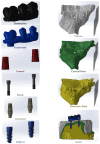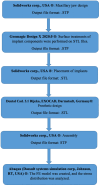Influence of Framework Material and Abutment Configuration on Fatigue Performance in Dental Implant Systems: A Finite Element Analysis
- PMID: 39336504
- PMCID: PMC11433853
- DOI: 10.3390/medicina60091463
Influence of Framework Material and Abutment Configuration on Fatigue Performance in Dental Implant Systems: A Finite Element Analysis
Abstract
Background and Objectives: This study uses finite element analysis to evaluate the impact of abutment angulation, types, and framework materials on the stress distribution and fatigue performance of dental implant systems. Materials and Methods: Three-dimensional models of maxillary three-unit fixed implant-supported prostheses were analyzed. Abutments with different angles and types were used. Two different framework materials were used. Conducted on implants, a force of 150 N was applied obliquely, directed from the palatal to the buccal aspect, at a specific angle of 30 degrees. The distribution of stress and fatigue performance were then assessed, considering the types of restoration frameworks used and the angles of the abutments in three distinct locations. The simulation aspect of the research was carried out utilizing Abaqus Software (ABAQUS 2020, Dassault Systems Simulation Corp., Johnston, RT, USA). Results: In all models, fatigue strengths in the premolar region were higher than in the molar region. Maximum stress levels were seen in models with angled implants. In almost all models with the zirconia framework, fatigue performance was slightly lower. Conclusions: According to the findings of this study, it was concluded that the use of metal-framework multi-unit restorations with minimum angulation has significant positive effects on the biomechanics and long-term success of implant treatments.
Keywords: fatigue performance; finite element analysis; implant-supported prostheses; von Mises stress.
Conflict of interest statement
The authors declare no conflicts of interest.
Figures

















References
-
- Yao K.-T., Chang T.-Y., Huang G.-J., Fang H.-W., Wang D.-H., Hsu M.-L. Survival of Four Conical Implant Abutment Connections After Removal of the Abutment Screw and Simulated Cyclic Loading: An In Vitro Comparative Study. J. Oral Implantol. 2023;49:393–400. doi: 10.1563/aaid-joi-D-22-00037. - DOI - PubMed
MeSH terms
Substances
LinkOut - more resources
Full Text Sources

